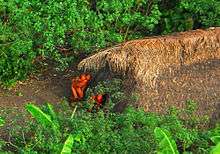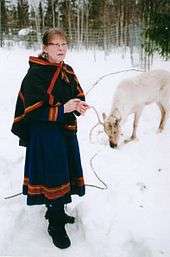Indigenous peoples
Indigenous peoples, also known in some regions as First peoples, First Nations, Aboriginal peoples or Native peoples or autochthonous peoples, are ethnic groups who are the original or earliest known inhabitants of an area, in contrast to groups that have settled, occupied or colonized the area more recently. Groups are usually described as indigenous when they maintain traditions or other aspects of an early culture that is associated with a given region.[1] Not all indigenous peoples share this characteristic, as many have adopted substantial elements of a colonizing culture, such as dress, religion or language. Indigenous peoples may be settled in a given region (sedentary) or exhibit a nomadic lifestyle across a large territory, but they are generally historically associated with a specific territory on which they depend. Indigenous societies are found in every inhabited climate zone and continent of the world except Antarctica.[2]
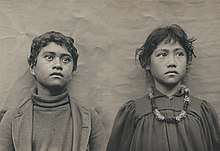
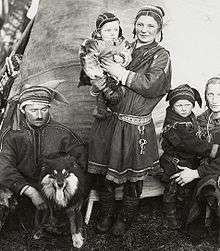
Since indigenous peoples are often faced with threats to their sovereignty, economic well-being and access to the resources on which their cultures depend, political rights have been set forth in international law by international organizations such as the United Nations, the International Labour Organization and the World Bank.[3] In 2007, the United Nations issued a Declaration on the Rights of Indigenous Peoples (UNDRIP) to guide member-state national policies to the collective rights of indigenous peoples, such as culture, identity, language and access to employment, health, education and natural resources. Estimates put the total population of indigenous peoples from 220 million to 350 million.[4]
International Day of the World's Indigenous Peoples is celebrated on 9 August each year.
Definitions
The term 'indigenous peoples' refers to culturally distinct groups affected by colonization. The term started being used in the 1970s as a way of linking experiences, issues and struggles of groups of colonized people across international borders. At this time 'Indigenous people(s)' also began to be used to describe a legal category in indigenous law created in international and national legislation. The use of the 's' in 'peoples' recognizes that there are real differences between different indigenous peoples.[5][6]
James Anaya, former Special Rapporteur on the Rights of Indigenous Peoples, has defined indigenous peoples as "living descendants of pre-invasion inhabitants of lands now dominated by others. They are culturally distinct groups that find themselves engulfed by other settler societies born of forces of empire and conquest".[7][8]
Indigenous is derived from the Latin word indigena, which is based on the root -genus, "to be born from", and the Old Latin prefix indu-, "in".[9] Notably, the origins of the term "indigenous" are not related in any way to the origins of the term "Indian", which until recently was commonly applied to indigenous peoples of the Americas. Any given people, ethnic group or community may be described as "indigenous" in reference to some particular region or location that they see as their traditional indigenous land claim.[10] Other terms for indigenous populations in use are 'First Peoples' or 'Native Peoples', 'First Nations' or 'People of the Land', 'Aboriginals', or 'Fourth World Peoples'.[5] The words original, autochthonous or first (as in Canada's First Nations) are also used.
The Merriam-Webster Dictionary defines a people as "a body of persons that are united by a common culture, tradition, or sense of kinship, which typically have common language, institutions, and beliefs, and often constitute a politically organized group".[11]
National definitions
Throughout history, different states designate the groups within their boundaries that are recognized as indigenous peoples according to international or national legislation by different terms. Indigenous people also include people indigenous based on their descent from populations that inhabited the country when non-indigenous religions and cultures arrived—or at the establishment of present state boundaries—who retain some or all of their own social, economic, cultural and political institutions, but who may have been displaced from their traditional domains or who may have resettled outside their ancestral domains.[12]
The status of the indigenous groups in the subjugated relationship can be characterized in most instances as an effectively marginalized or isolated in comparison to majority groups or the nation-state as a whole. Their ability to influence and participate in the external policies that may exercise jurisdiction over their traditional lands and practices is very frequently limited. This situation can persist even in the case where the indigenous population outnumbers that of the other inhabitants of the region or state; the defining notion here is one of separation from decision and regulatory processes that have some, at least titular, influence over aspects of their community and land rights.[13]
In a ground-breaking 1997 decision involving the Ainu people of Japan, the Japanese courts recognized their claim in law, stating that "If one minority group lived in an area prior to being ruled over by a majority group and preserved its distinct ethnic culture even after being ruled over by the majority group, while another came to live in an area ruled over by a majority after consenting to the majority rule, it must be recognized that it is only natural that the distinct ethnic culture of the former group requires greater consideration."[14]
In Russia, definition of "indigenous peoples" is contested largely referring to a number of population (less than 50 000 people), and neglecting self-identification, origin from indigenous populations who inhabited the country or region upon invasion, colonization or establishment of state frontiers, distinctive social, economic and cultural institutions.[15][1] Thus, indigenous people of Russia such as Sakha, Komi, Karelian and others are not considered as such due to the size of the population (more than 50 000 people), and consequently they "are not the subjects of the specific legal protections."[16]
The presence of external laws, claims and cultural mores either potentially or actually act to variously constrain the practices and observances of an indigenous society. These constraints can be observed even when the indigenous society is regulated largely by its own tradition and custom. They may be purposefully imposed, or arise as unintended consequence of trans-cultural interaction. They may have a measurable effect, even where countered by other external influences and actions deemed beneficial or that promote indigenous rights and interests.[17]
United Nations
The first meeting of the United Nations Working Group on Indigenous Populations was on 9 August 1982 and this date is now celebrated as the International Day of the World's Indigenous Peoples.[18]
In 1982 the United Nations Working Group on Indigenous Populations (WGIP) accepted as a preliminary definition a formulation put forward by Mr. José R. Martínez-Cobo, Special Rapporteur on Discrimination against Indigenous Populations. This definition has some limitations, because the definition applies mainly to pre-colonial populations, and would likely exclude other isolated or marginal societies.[19]
Indigenous communities, peoples, and nations are those that, having a historical continuity with pre-invasion and pre-colonial societies that developed on their territories, consider themselves distinct from other sectors of the societies now prevailing in those territories, or parts of them. They form at present non-dominant sectors of society and are determined to preserve, develop, and transmit to future generations their ancestral territories, and their ethnic identity, as the basis of their continued existence as peoples, in accordance with their own cultural patterns, social institutions and legal systems.[20]
The United Nations Permanent Forum on Indigenous Issues (UNPFII), a high- level advisory body to the United Nations Economic and Social Council, was established on 28 July 2000 with the mandate to deal with indigenous issues related to economic and social development, culture, the environment, education, health and human rights.
The primary impetus in considering indigenous identity comes from the post-colonial movements and considering the historical impacts on populations by the European imperialism. The first paragraph of the Introduction of a report published in 2009 by the Secretariat of the Permanent Forum on Indigenous Issues published a report,[21] states
For centuries, since the time of their colonization, conquest or occupation, indigenous peoples have documented histories of resistance, interface or cooperation with states, thus demonstrating their conviction and determination to survive with their distinct sovereign identities. Indeed, indigenous peoples were often recognized as sovereign peoples by states, as witnessed by the hundreds of treaties concluded between indigenous peoples and the governments of the United States, Canada, New Zealand and others.[22]
In May 2016, the Fifteenth Session of the United Nations Permanent Forum on Indigenous Issues (UNPFII) affirmed that indigenous people (also termed aboriginal people, native people, or autochthonous people) are distinctive groups protected in international or national legislation as having a set of specific rights based on their linguistic and historical ties to a particular territory, prior to later settlement, development, and or occupation of a region.[23] The session affirms that, since indigenous peoples are vulnerable to exploitation, marginalization, oppression, forced assimilation, and genocide by nation states formed from colonizing populations or by different, politically dominant ethnic groups, individuals and communities maintaining ways of life indigenous to their regions are entitled to special protection.
History
Classical antiquity
Greek sources of the Classical period acknowledge the prior existence of indigenous people(s), whom they referred to as "Pelasgians". These peoples inhabited lands surrounding the Aegean Sea before the subsequent migrations of the Hellenic ancestors claimed by these authors. The disposition and precise identity of this former group is elusive, and sources such as Homer, Hesiod and Herodotus give varying, partially mythological accounts. However, it is clear that cultures existed whose indigenous characteristics were distinguished by the subsequent Hellenic cultures (and distinct from non-Greek speaking "foreigners", termed "barbarians" by the historical Greeks).
Greco-Roman society flourished between 330 BCE and 640 CE and commanded successive waves of conquests that gripped more than half of the globe. But because already existent populations within other parts of Europe at the time of classical antiquity had more in common culturally speaking with the Greco-Roman world, the intricacies involved in expansion across the European frontier were not so contentious relative to indigenous issues.[24]
However, when it came to expansion in other parts of the world, namely Asia, Africa, and the Middle East, then totally new cultural dynamics had entered into the equation, and this expansion became a forerunner of what was to take the Americas, Southeast Asia, and the Pacific by storm in more recent times. Thus, the idea that expansionist societies may encounter peoples who possess cultural customs and racial appearances strikingly different from those of the colonizing power was not new to the Renaissance or the Enlightenment.
European expansion and colonialism
The rapid and extensive spread of the various European powers from the early 15th century onward had a profound impact upon many of the indigenous cultures with whom they came into contact. The exploratory and colonial ventures in the Americas, Africa, Asia and the Pacific often resulted in territorial and cultural conflicts, and the intentional or unintentional displacement and devastation of the indigenous populations.
Encounters between explorers and indigenous populations in the rest of the world often introduced new infectious diseases, which sometimes caused local epidemics of extraordinary virulence. For example, smallpox, measles, malaria, yellow fever, and other diseases were unknown in pre-Columbian America and Australia.
The Canary Islands had an indigenous population called the Guanches whose origin is still the subject of discussion among historians and linguists.[25]
Population and distribution
Indigenous societies range from those who have been significantly exposed to the colonizing or expansionary activities of other societies (such as the Maya peoples of Mexico and Central America) through to those who as yet remain in comparative isolation from any external influence (such as the Sentinelese and Jarawa of the Andaman Islands).
Precise estimates for the total population of the world's indigenous peoples are very difficult to compile, given the difficulties in identification and the variances and inadequacies of available census data. The United Nations estimates that there are over 370 million indigenous people living in over 70 countries worldwide.[26] This would equate to just fewer than 6% of the total world population. This includes at least 5000 distinct peoples[27] in over 72 countries.
Contemporary distinct indigenous groups survive in populations ranging from only a few dozen to hundreds of thousands and more. Many indigenous populations have undergone a dramatic decline and even extinction, and remain threatened in many parts of the world. Some have also been assimilated by other populations or have undergone many other changes. In other cases, indigenous populations are undergoing a recovery or expansion in numbers.
Certain indigenous societies survive even though they may no longer inhabit their "traditional" lands, owing to migration, relocation, forced resettlement or having been supplanted by other cultural groups. In many other respects, the transformation of culture of indigenous groups is ongoing, and includes permanent loss of language, loss of lands, encroachment on traditional territories, and disruption in traditional ways of life due to contamination and pollution of waters and lands.
Environmental and economic benefits of having indigenous peoples tend land
A WRI report mentions that “tenure-secure” indigenous lands generates billions and sometimes trillions of dollars’ worth of benefits in the form of carbon sequestration, reduced pollution, clean water and more. It says that tenure-secure indigenous lands have low deforestation rates,[28][29] they help to reduce GHG emissions, control erosion and flooding by anchoring soil, and provide a suite of other local, regional and global ecosystem services. However, many of these communities find themselves on the front lines of the deforestation crisis, and their lives and livelihoods threatened.[30][31][32]
Indigenous peoples by region
Indigenous populations are distributed in regions throughout the globe. The numbers, condition and experience of indigenous groups may vary widely within a given region. A comprehensive survey is further complicated by sometimes contentious membership and identification.
Africa
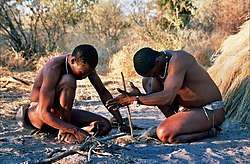
In the post-colonial period, the concept of specific indigenous peoples within the African continent has gained wider acceptance, although not without controversy. The highly diverse and numerous ethnic groups that comprise most modern, independent African states contain within them various peoples whose situation, cultures and pastoralist or hunter-gatherer lifestyles are generally marginalized and set apart from the dominant political and economic structures of the nation. Since the late 20th century these peoples have increasingly sought recognition of their rights as distinct indigenous peoples, in both national and international contexts.
Though the vast majority of African peoples are indigenous in the sense that they originate from that continent, in practice, identity as an indigenous people per the modern definition is more restrictive, and certainly not every African ethnic group claims identification under these terms. Groups and communities who do claim this recognition are those who, by a variety of historical and environmental circumstances, have been placed outside of the dominant state systems, and whose traditional practices and land claims often come into conflict with the objectives and policies implemented by governments, companies and surrounding dominant societies.
Americas
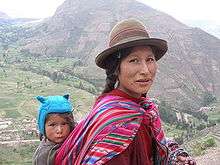
Indigenous peoples of the American continent are broadly recognized as being those groups and their descendants who inhabited the region before the arrival of European colonizers and settlers (i.e., Pre-Columbian). Indigenous peoples who maintain, or seek to maintain, traditional ways of life are found from the high Arctic north to the southern extremities of Tierra del Fuego.
The impact of European colonization of the Americas on the indigenous communities has been in general quite severe, with many authorities estimating ranges of significant population decline primarily due to disease but also violence. The extent of this impact is the subject of much continuing debate. Several peoples shortly thereafter became extinct, or very nearly so.
All nations in North and South America have populations of indigenous peoples within their borders. In some countries (particularly in Latin American), indigenous peoples form a sizable component of the overall national population — in Bolivia they account for an estimated 56–70% of the total nation, and at least half of the population in Guatemala and the Andean and Amazonian nations of Peru. In English, indigenous peoples are collectively referred to by different names that vary by region and include such ethnonyms as Native Americans, Amerindians, and American Indians. In Spanish or Portuguese speaking countries one finds the use of terms such as índios, pueblos indígenas, amerindios, povos nativos, povos indígenas, and, in Peru, Comunidades Nativas (Native Communities), particularly among Amazonian societies like the Urarina[33] and Matsés. In Chile there are indigenous peoples like the Mapuches in the Center-South and the Aymaras in the North; also the Rapa Nui indigenous to Easter Island are a Polynesian people.
In Brazil, the Portuguese term índio is used by most of the population, the media, the indigenous peoples themselves and even the government (FUNAI is an acronym for the Fundação Nacional do Índio), although its Hispanic equivalent indio is widely considered not politically correct and is falling into disuse.
Indigenous peoples in Canada comprise the First Nations,[34] Inuit[35] and Métis.[36] The descriptors "Indian" and "Eskimo" have fallen into disuse in Canada.[37][38] According to the 2016 Census, there are around 1 670 000 Aboriginal people.[39] There are currently over 600 recognized First Nations governments or bands spread across Canada with distinctive Aboriginal cultures, languages, art, and music.[40][41] National Aboriginal Day recognizes the cultures and contributions of Aboriginals to the history of Canada
The Inuit have achieved a degree of administrative autonomy with the creation in 1999 of the territories of Nunavik (in Northern Quebec), Nunatsiavut (in Northern Labrador) and Nunavut, which was until 1999 a part of the Northwest Territories.
The autonomous Danish territory of Greenland is also home to a majority population of Inuit (about 85%) who settled the area in the 13th century, displacing the indigenous Dorset people and Greenlandic Norse.[42][43][44][45]
In the United States, the combined populations of Native Americans, Inuit and other indigenous designations totaled 2,786,652 (constituting about 1.5% of 2003 U.S. census figures). Some 563 scheduled tribes are recognized at the federal level, and a number of others recognized at the state level.
In Mexico, approximately 6,000,000 (constituting about 6.7% of 2005 Mexican census figures) identify as Indígenas (Spanish for natives or indigenous peoples). In the southern states of Chiapas, Yucatán and Oaxaca they constitute 26.1%, 33.5% and 35.3%, respectively, of the population. In these states several conflicts and episodes of civil war have been conducted, in which the situation and participation of indigenous societies were notable factors (see for example EZLN).

The Amerindians make up 0.4% of all Brazilian population, or about 700,000 people.[46] Indigenous peoples are found in the entire territory of Brazil, although the majority of them live in Indian reservations in the North and Center-Western part of the country. On 18 January 2007, FUNAI reported that it had confirmed the presence of 67 different uncontacted peoples in Brazil, up from 40 in 2005. With this addition Brazil has now overtaken the island of New Guinea as the country having the largest number of uncontacted peoples.[47]
Asia
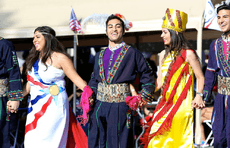
The vast regions of Asia contain the majority of the world's present-day indigenous populations, about 70% according to IWGIA figures.
Western Asia
The Armenians are the indigenous people of the Armenian Highlands. There are currently more Armenians living outside their ancestral homeland because of the Armenian Genocide of 1915.
The Yazidis are indigenous to the Sinjar mountain range in northern Iraq. The Yazidis are ethnically Kurd but are a religious minority of the Kurdish people.[48] The Kurds, as a whole, are one of the indigenous peoples of Mesopotamia (south-eastern Turkey, north-eastern Syria, northern Iraq, north-western Iran and parts Armenia).[49][50]
The Jews are indigenous to the Levantine region in Israel, western Jordan, and southwestern Syria. Their belief system is Judaism and language Hebrew. They are descendants of the 12 Tribes of Israel, and the ancient kingdoms of Israel and Judeah. Due to the historical exile by the Roman Empire, 55% of today’s Jewry live in diaspora.[51] 45% of the world's Jews live in Israel, which was created through the movement of Zionism, one of the only successful national liberation movements in the world [52].
The Assyrians are indigenous to Mesopotamia.[53] They claim descent from the ancient Neo-Assyrian Empire, and lived in what was Assyria, their original homeland, and still speak dialects of Aramaic, the official language of the Assyrian Empire.
South Asia
The most substantial populations of indigenous people are in India, which constitutionally recognizes a range of "Scheduled Tribes" within its borders. These various people number about 200 million. But these terms "indigenous people" and "tribal people" are different.[54]
There are also indigenous people residing in the hills of Northern, North-eastern and Southern India like the Tamils (of Tamil Nadu), Shina, Kalasha, Khowar, Burusho, Balti, Wakhi, Domaki, Nuristani, Kohistani, Bakkarwal, Meenas, Ladakhi, Lepcha, Bhutia (of Sikkim), Naga (of Nagaland), indigenous Assamese communities, Mizo (of Mizoram), Tripuri (Tripura), Adi and Nyishi (Arunachal Pradesh), Kodava (of Kodagu), Toda, Kurumba, Kota (of the Nilgiris), Irulas and others.
India's Andaman and Nicobar Islands in the Indian Ocean are also home to several indigenous groups such as the Andamanese of Strait Island, the Jarawas of Middle Andaman and South Andaman Islands, the Onge of Little Anadaman Island and the uncontacted Sentinelese of North Sentinel Island. They are registered and protected by the Indian government.
In Sri Lanka, the indigenous Veddah people constitute a small minority of the population today.
North Asia
The Russians invaded Siberia and conquered the indigenous people in the 17th–18th centuries.
Nivkh people are an ethnic group indigenous to Sakhalin, having a few speakers of the Nivkh language, but their fisher culture has been endangered due to the development of oil field of Sakhalin from 1990s.[55]
The Russian government recognizes only 40 ethnic groups as indigenous peoples, even though there are other 30 groups to be counted as such. The reason of nonrecognition is the size of the population and relatively late advent to their current regions, thus indigenous peoples in Russia should be numbered less than 50,000 people.[56][57][58]
East Asia
Ainu people are an ethnic group indigenous to Hokkaidō, the Kuril Islands, and much of Sakhalin. As Japanese settlement expanded, the Ainu were pushed northward and fought against the Japanese in Shakushain's Revolt and Menashi-Kunashir Rebellion, until by the Meiji period they were confined by the government to a small area in Hokkaidō, in a manner similar to the placing of Native Americans on reservations.[59]
The Dzungar Oirats are indigenous to the Dzungaria in Northern Xinjiang.
The Pamiris are indigenous to the Tashkurgan in Xinjiang.
The Tibetans are indigenous to Tibet.
The Ryukyuan people are indigenous to the Ryukyu Islands.
The languages of Taiwanese aborigines have significance in historical linguistics, since in all likelihood Taiwan was the place of origin of the entire Austronesian language family, which spread across Oceania.[60][61][62].
Southeast Asia
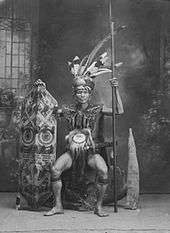
The Malay Singaporeans are the indigenous people of Singapore, inhabiting it since the Austronesian migration. They had established the Kingdom of Singapura back in the 13th century. The name Singapore itself comes from the Malay word Singapura (Singa=Lion, Pura=City) which means the Lion City.
The Cham are the indigenous people of the former state of Champa which was conquered by Vietnam in the Cham–Vietnamese wars during Nam tiến. The Cham in Vietnam are only recognized as a minority, and not as an indigenous people by the Vietnamese government despite being indigenous to the region.
The Degar (Montagnards) are indigenous to Central Highlands (Vietnam) and were conquered by the Vietnamese in the Nam tiến.
The Khmer Krom are the indigenous people of the Mekong Delta and Saigon which were acquired by Vietnam from Cambodian King Chey Chettha II in exchange for a Vietnamese princess.
In Indonesia, there are 50 to 70 million people who classify as indigenous peoples.[63] However, the Indonesian government does not recognize the existence of indigenous peoples, classifying every Native Indonesian ethnic group as "indigenous" despite the clear cultural distinctions of certain groups.[64] This problem is shared by many other countries in the ASEAN region.
In the Philippines, there are 135 ethno-linguistic groups, majority of which are considered as indigenous peoples by mainstream indigenous ethnic groups in the country. The indigenous people of Cordillera Administrative Region and Cagayan Valley in the Philippines are the Igorot people. The indigenous peoples of Mindanao are the Lumad peoples and the Moro (Tausug, Maguindanao Maranao and others) who also live in the Sulu archipelago. There are also others sets of indigenous peoples in Palawan, Mindoro, Visayas, and the rest central and south Luzon. The country has one of the largest indigenous peoples population in the world.
In Myanmar indigenous peoples include the Shan, the Karen, the Rakhine, the Karenni, the Chin, the Kachin and the Mon. However, there are more ethnic groups that are considered indigenous, for example, the Akha, the Lisu, the Lahu or the Mru, among others[65].
Europe
In Europe, the majority of ethnic groups are indigenous to the region in the sense of having occupied it for several centuries or millennia. Present-day indigenous populations as recognized by the UN definition, however, are relatively few, and mainly confined to its north and far east.
Notable indigenous minority populations in Europe which are recognized by the UN include the Finno-Ugric Nenets, Samoyed, and Komi peoples of northern Russia; Circassians of southern Russia and the North Caucasus; Crimean Tatars of Crimea in Ukraine; and Sámi peoples of northern Norway, Sweden, and Finland and northwestern Russia (in an area also referred to as Sápmi).[66]
Oceania

In Australia the indigenous populations are the Aboriginal Australian peoples (comprising many different nations and tribes) and the Torres Strait Islander peoples (also with sub-groups). These groups are often together spoken of as Indigenous Australians.
Polynesian, Melanesian and Micronesian peoples originally populated many of the present-day Pacific Island countries in the Oceania region over the course of thousands of years. European, American, Chilean and Japanese colonial expansion in the Pacific brought many of these areas under non-indigenous administration, mainly during the 19th century. During the 20th century several of these former colonies gained independence and nation-states formed under local control. However, various peoples have put forward claims for indigenous recognition where their islands are still under external administration; examples include the Chamorros of Guam and the Northern Marianas, and the Marshallese of the Marshall Islands. Some islands remain under administration from Paris, Washington, London or Wellington.
The remains of at least 25 miniature humans, who lived between 1,000 and 3,000 years ago, were recently found on the islands of Palau in Micronesia.[67]
In most parts of Oceania, indigenous peoples outnumber the descendants of colonists. Exceptions include Australia, New Zealand and Hawaii. According to the 2013 census, New Zealand Māori make up 14.9% of the population of New Zealand, with less than half (46.5%) of all Māori residents identifying solely as Māori. The Māori are indigenous to Polynesia and settled New Zealand relatively recently, with migrations thought to have occurred in the 13th century CE. In New Zealand pre-contact Māori groups did not necessarily see themselves as a single people, thus grouping into tribal (iwi) arrangements has become a more formal arrangement in more recent times. Many Māori national leaders signed a treaty with the British, the Treaty of Waitangi (1840), seen in some circles as forming the modern geo-political entity that is New Zealand.
A majority of the Papua New Guinea (PNG) population is indigenous, with more than 700 different nationalities recognized in a total population of 8 million.[68] The country's constitution and key statutes identify traditional or custom-based practices and land tenure, and explicitly set out to promote the viability of these traditional societies within the modern state. However, conflicts and disputes concerning land use and resource rights continue between indigenous groups, the government, and corporate entities.
Indigenous rights and other issues
| Part of a series on |
| Indigenous rights |
|---|
| Rights |
| Governmental organizations |
| NGOs and political groups |
| Issues |
| Legal representation |
| Category |
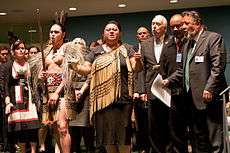
Indigenous peoples confront a diverse range of concerns associated with their status and interaction with other cultural groups, as well as changes in their inhabited environment. Some challenges are specific to particular groups; however, other challenges are commonly experienced.[69] These issues include cultural and linguistic preservation, land rights, ownership and exploitation of natural resources, political determination and autonomy, environmental degradation and incursion, poverty, health, and discrimination.
The interaction between indigenous and non-indigenous societies throughout history has been complex, ranging from outright conflict and subjugation to some degree of mutual benefit and cultural transfer. A particular aspect of anthropological study involves investigation into the ramifications of what is termed first contact, the study of what occurs when two cultures first encounter one another. The situation can be further confused when there is a complicated or contested history of migration and population of a given region, which can give rise to disputes about primacy and ownership of the land and resources.
Wherever indigenous cultural identity is asserted, common societal issues and concerns arise from the indigenous status. These concerns are often not unique to indigenous groups. Despite the diversity of indigenous peoples, it may be noted that they share common problems and issues in dealing with the prevailing, or invading, society. They are generally concerned that the cultures of indigenous peoples are being lost and that indigenous peoples suffer both discrimination and pressure to assimilate into their surrounding societies. This is borne out by the fact that the lands and cultures of nearly all of the peoples listed at the end of this article are under threat. Notable exceptions are the Sakha and Komi peoples (two northern indigenous peoples of Russia), who now control their own autonomous republics within the Russian state, and the Canadian Inuit, who form a majority of the territory of Nunavut (created in 1999). Despite the control of their territories, many Sakha people have lost their lands as a result of the Russian Homestead Act, which allows any Russian citizen to own any land in the Far Eastern region of Russia. In Australia, a landmark case, Mabo v Queensland (No 2),[70] saw the High Court of Australia reject the idea of terra nullius. This rejection ended up recognizing that there was a pre-existing system of law practised by the Meriam people.
A 2009 United Nations publication says "Although indigenous peoples are often portrayed as a hindrance to development, their cultures and traditional knowledge are also increasingly seen as assets. It is argued that it is important for the human species as a whole to preserve as wide a range of cultural diversity as possible, and that the protection of indigenous cultures is vital to this enterprise."[22]
Human rights violations
The Bangladesh Government has stated that there are "no indigenous peoples in Bangladesh."[71] This has angered the indigenous peoples of Chittagong Hill Tracts, Bangladesh, collectively known as the Jumma.[72] Experts have protested against this move of the Bangladesh Government and have questioned the Government's definition of the term "indigenous peoples."[73][74] This move by the Bangladesh Government is seen by the indigenous peoples of Bangladesh as another step by the Government to further erode their already limited rights.[75]
Hindus and Chams have both experienced religious and ethnic persecution and restrictions on their faith under the current Vietnamese government, with the Vietnamese state confiscating Cham property and forbidding Cham from observing their religious beliefs. Hindu temples were turned into tourist sites against the wishes of the Cham Hindus. In 2010 and 2013 several incidents occurred in Thành Tín and Phươc Nhơn villages where Cham were murdered by Vietnamese. In 2012, Vietnamese police in Chau Giang village stormed into a Cham Mosque, stole the electric generator, and also raped Cham girls.[76] Cham in the Mekong Delta have also been economically marginalised, with ethnic Vietnamese settling on land previously owned by Cham people with state support.[77]
The Indonesian government has outright denied the existence of indigenous peoples within the countries' borders. In 2012, Indonesia stated that ‘The Government of Indonesia supports the promotion and protection of indigenous people worldwide ... Indonesia, however, does not recognize the application of the indigenous peoples concept ... in the country’.[78] Along with the brutal treatment of the country's Papuan people (a conservative estimate places the violent deaths at 100,000 people in West New Guinea since Indonesian occupation in 1963, see Papua Conflict) has led to Survival International condemning Indonesia for treating its indigenous peoples as the worst in the world.[78]
The Vietnamese viewed and dealt with the indigenous Montagnards from the Central Highlands as "savages," which caused a Montagnard uprising against the Vietnamese.[79] The Vietnamese were originally centered around the Red River Delta but engaged in conquest and seized new lands such as Champa, the Mekong Delta (from Cambodia) and the Central Highlands during Nam Tien. While the Vietnamese received strong Chinese influence in their culture and civilization and were Sinicized, and the Cambodians and Laotians were Indianized, the Montagnards in the Central Highlands maintained their own indigenous culture without adopting external culture and were the true indigenous of the region. To hinder encroachment on the Central Highlands by Vietnamese nationalists, the term Pays Montagnard du Sud-Indochinois (PMSI) emerged for the Central Highlands along with the indigenous being addressed by the name Montagnard.[80] The tremendous scale of Vietnamese Kinh colonists flooding into the Central Highlands has significantly altered the demographics of the region.[81] The anti-ethnic minority discriminatory policies by the Vietnamese, environmental degradation, deprivation of lands from the indigenous people, and settlement of indigenous lands by an overwhelming number of Vietnamese settlers led to massive protests and demonstrations by the Central Highland's indigenous ethnic minorities against the Vietnamese in January–February 2001. This event gave a tremendous blow to the claim often published by the Vietnamese government that in Vietnam “There has been no ethnic confrontation, no religious war, no ethnic conflict. And no elimination of one culture by another.”[82]
Health issues
In December 1993, the United Nations General Assembly proclaimed the International Decade of the World's Indigenous People, and requested UN specialized agencies to consider with governments and indigenous people how they can contribute to the success of the Decade of Indigenous People, commencing in December 1994. As a consequence, the World Health Organization, at its Forty-seventh World Health Assembly, established a core advisory group of indigenous representatives with special knowledge of the health needs and resources of their communities, thus beginning a long-term commitment to the issue of the health of indigenous peoples.[83]
The WHO notes that "Statistical data on the health status of indigenous peoples is scarce. This is especially notable for indigenous peoples in Africa, Asia and eastern Europe," but snapshots from various countries (where such statistics are available) show that indigenous people are in worse health than the general population, in advanced and developing countries alike: higher incidence of diabetes in some regions of Australia;[84] higher prevalence of poor sanitation and lack of safe water among Twa households in Rwanda;[85] a greater prevalence of childbirths without prenatal care among ethnic minorities in Vietnam;[86] suicide rates among Inuit youth in Canada are eleven times higher than the national average;[87] infant mortality rates are higher for indigenous peoples everywhere.[88]
The first UN publication on the State of the World's Indigenous Peoples revealed alarming statistics about indigenous peoples' health. Health disparities between indigenous and non-indigenous populations are evident in both developed and developing countries. Native Americans in the United States are 600 times more likely to acquire tuberculosis and 62% more likely to commit suicide than the non-indigenous American population. Tuberculosis, obesity, and type 2 diabetes are major health concerns for the indigenous in developed countries.[89] Globally, health disparities touch upon nearly every health issue, including HIV/AIDS, cancer, malaria, cardiovascular disease, malnutrition, parasitic infections, and respiratory diseases, affecting indigenous peoples at much higher rates. Many causes of indigenous children's mortality could be prevented. Poorer health conditions amongst indigenous peoples result from longstanding complex issues, such as extreme poverty, but also the intentional marginalization and dispossession of indigenous peoples by dominant, non-indigenous populations.[89]
Racism and discrimination
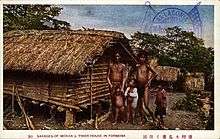
Indigenous peoples have frequently been subjected to various forms of racism and discrimination. Indigenous peoples have been denoted primitives, savages[90] or uncivilized. These terms occurred commonly during the heyday of European colonial expansion, but still continue in use in certain societies in modern times.[91]
During the 17th century, Europeans commonly labeled indigenous peoples as "uncivilized". Some philosophers, such as Thomas Hobbes (1588-1679), considered indigenous people to be merely "savages". Others (especially literary figures in the 18th century) popularised the concept of "noble savages". Those who were close to the Hobbesian view tended to believe themselves to have a duty to "civilize" and "modernize" the indigenous. Although anthropologists, especially from Europe, used to apply these terms to all tribal cultures, the practice has fallen into disfavor as demeaning and is, according to many anthropologists, not only inaccurate, but dangerous.
Survival International runs a campaign to stamp out media portrayal of indigenous peoples as "primitive" or "savages".[92] Friends of Peoples Close to Nature considers not only that indigenous culture should be respected as not being inferior, but also sees indigenous ways of life as offering a lesson in sustainability and as a part of the struggle within the "corrupted" western world, from which the threat stems.[93]
After World War I (1914-1918) many Europeans came to doubt the morality of the means used to "civilize" peoples. At the same time, the anti-colonial movement, and advocates of indigenous peoples, argued that words such as "civilized" and "savage" were products and tools of colonialism, and argued that colonialism itself was savagely destructive. In the mid-20th century European attitudes began to shift to the view that indigenous and tribal peoples should have the right to decide for themselves what should happen to their ancient cultures and ancestral lands.[94]
Cultural appropriation
The cultures of indigenous peoples can become a happy hunting ground for New Age advocates seeking to find ancient traditional truths, spiritualities and practices to appropriate into their worldviews.[95]
Environmental injustice
At an international level, indigenous peoples have received increased recognition of their environmental rights since 2002, but few countries respect these rights in reality. The UN Declaration on the Rights of Indigenous Peoples, adopted by the General Assembly in 2007, established indigenous peoples' right to self-determination, implying several rights regarding natural resource management. In countries where these rights are recognized, land titling and demarcation procedures are often put on delay, or leased out by the state as concessions for extractive industries without consulting indigenous communities.[89]
Many in the United States federal government are in favor of exploiting oil reserves in the Arctic National Wildlife Refuge, where the Gwich'in indigenous people rely on herds of caribou. Oil drilling could destroy thousands of years of culture for the Gwich'in. On the other hand, the Inupiat Eskimo, another indigenous community in the region, favors oil drilling because they could benefit economically.[96]
The introduction of industrial agricultural technologies such as fertilizers, pesticides, and large plantation schemes have destroyed ecosystems that indigenous communities formerly depended on, forcing resettlement. Development projects such as dam construction and resource extraction have displaced large numbers of indigenous peoples, often without providing compensation. Governments have forced indigenous peoples off of their native lands in the name of ecotourism and national park development. Indigenous women are especially affected by land dispossession because they must walk longer distances for water and fuel wood. These women also become economically dependent on men when they lose their livelihoods. Indigenous groups asserting their rights has most often results in torture, imprisonment, or death.[89]
Most indigenous populations are already subject to the deleterious effects of climate change. Climate change has not only environmental, but also human rights and socioeconomic implications for indigenous communities. The World Bank acknowledges climate change as an obstacle to Millennium Development Goals, notably the fight against poverty, disease, and child mortality, in addition to environmental sustainability.[89]
See also
- Collective rights
- Colonialism
- Cultural appropriation
- Ethnic minority
- Genocide of indigenous peoples
- Human rights
- The Image Expedition
- Indigenism
- Indigenous Futurisms
- Indigenous intellectual property
- Indigenous Peoples Climate Change Assessment Initiative
- Indigenous Peoples' Day of America
- Indigenous rights
- Intangible cultural heritage
- International Day of the World's Indigenous Peoples
- Isuma
- List of active NGOs of national minorities
- List of ethnic groups
- List of indigenous peoples
- Missing and murdered Indigenous women
- Uncontacted peoples
- United Nations Permanent Forum on Indigenous Issues
- Unrepresented Nations and Peoples Organization
- Virgin soil epidemic
References
- ILO definition of indigenous people
- Acharya, Deepak and Shrivastava Anshu (2008): Indigenous Herbal Medicines: Tribal Formulations and Traditional Herbal Practices, Aavishkar Publishers Distributor, Jaipur, India. ISBN 978-81-7910-252-7. p. 440
- Sanders, Douglas (1999). "Indigenous peoples: Issues of definition". International Journal of Cultural Property. 8: 4–13. doi:10.1017/S0940739199770591.
- Bodley 2008:2
- Smith, Linda Tuhiwai (2012). Decolonizing methodologies : research and indigenous peoples (Second ed.). Dunedin, New Zealand: Otago University Press. ISBN 978-1-877578-28-1. OCLC 805707083.
- Robert K. Hitchcock, Diana Vinding, Indigenous Peoples' Rights in Southern Africa, IWGIA, 2004, p. 8 based on Working Paper by the Chairperson-Rapporteur, Mrs. Erica-Irene A. Daes, on the concept of indigenous people. UN-Dokument E/CN.4/Sub.2/AC.4/1996/2 (, unhchr.ch)
- S. James Anaya, Indigenous Peoples in International Law, 2nd ed., Oxford University press, 2004, p. 3; Professor Anaya teaches Native American Law, and is the third Commission on Human Rights Special Rapporteur on the Human Rights and Fundamental Freedoms of Indigenous People
- Martínez-Cobo (1986/7), paras. 379–82,
- "indigene, adj. and n." OED Online. Oxford University Press, September 2016. Web. 22 November 2016.
- Mario Blaser, Harvey A. Feit, Glenn McRae, In the Way: Indigenous Peoples, Life Projects, and Development, IDRC, 2004, p. 53
- Silke Von Lewinski, Indigenous Heritage and Intellectual Property: Genetic Resources, Traditional Knowledge, and Folklore, Kluwer Law International, 2004, pp. 130–31
- "Indigenous and Tribal People's Rights Over Their Ancestral Lands and Natural Resources". cidh.org. Retrieved 30 May 2020.
- "Indigenous Peoples". World Bank. Retrieved 11 April 2020.
- Judgment of the Sapporo District Court, Civil Division No. 3, 27 March 1997, in (1999) 38 ILM, p. 419
- IWGIA (2012). Briefing note. Indigenous people in the Russian Federation
- Fondahl, G., Filippova, V., Mack, L. (2015). Indigenous peoples in the new Arctic. In B.Evengard, O.Nymand Larsen, O.Paasche (Eds), The New Arctic (pp. 7–22). Springer
- "Indigenous and Tribal People's Rights Over Their Ancestral Lands and Natural Resources". cidh.org. Retrieved 30 May 2020.
- "International Day of the World's Indigenous Peoples - 9 August". www.un.org. Retrieved 11 March 2020.
- Study of the Problem of Discrimination Against Indigenous Populations, p. 10, Paragraph 25, 30 July 1981, UN EASC
- "A working definition, by José Martinez Cobo". IWGIA - International Work Group for Indigenous Affairs. 9 April 2011. Archived from the original on 26 October 2019. Retrieved 11 March 2020.
- State of the World's Indigenous Peoples, p. 1 Archived 15 February 2010 at the Wayback Machine
- State of the World's Indigenous Peoples, Secretariat of Permanent Forum on Indigenous Issues, UN, 2009 Archived 15 February 2010 at the Wayback Machine
- Coates 2004:12
- Hall, Gillette, and Harry Anthony Patrinos. Indigenous Peoples, Poverty and Human Development in Latin America. New York: Palgrave MacMillan, n.d. Google Scholar. Web. 11 Mar. 2013
- Old World Contacts/Colonists/Canary Islands Archived 13 October 2007 at the Wayback Machine. Ucalgary.ca (22 June 1999). Retrieved on 2011-10-11.
- "Who are indigenous peoples?" (PDF). Retrieved 2 January 2020.
- "Indigenous issues". International Work Group on Indigenous Affairs. Retrieved 5 September 2005.
- Protecting Indigenous Land Rights Makes Good Economic Sense
- Climate Benefits, Tenure Costs
- Defending the defenders: tropical forests in the front line
- Protect indigenous people’s land rights and the whole world will benefit
- What role do indigenous people and forests have in a sustainable future?
- Dean, Bartholomew 2009 Urarina Society, Cosmology, and History in Peruvian Amazonia, Gainesville: University Press of Florida ISBN 978-0-8130-3378-5
- "Civilization.ca – Gateway to Aboriginal Heritage–Culture". Canadian Museum of Civilization Corporation. Government of Canada. 12 May 2006. Retrieved 18 September 2009.
- "Inuit Circumpolar Council (Canada) – ICC Charter". Inuit Circumpolar Council > ICC Charter and By-laws > ICC Charter. 2007. Archived from the original on 5 March 2010. Retrieved 18 September 2009.
- "In the Kawaskimhon Aboriginal Moot Court Factum of the Federal Crown Canada" (PDF). Faculty of Law. University of Manitoba. 2007. p. 2. Archived from the original (PDF) on 26 March 2009. Retrieved 18 September 2009.
- "Words First An Evolving Terminology Relating to Aboriginal Peoples in Canada". Communications Branch of Indian and Northern Affairs Canada. 2004. Archived from the original on 14 November 2007. Retrieved 26 June 2010.
- "Terminology of First Nations, Native, Aboriginal and Métis" (PDF). Aboriginal Infant Development Programs of BC. 2009. Archived from the original (PDF) on 14 July 2010. Retrieved 26 June 2010.
- Statistics Canada, Canada (table), Census Profile, 2016 Census of Population, Catalogue № 98-316-X2016001 (Ottawa: 2017‑11‑29); ———, Aboriginal Peoples Reference Guide, 2016 Census of Population, Catalogue № 98‑500‑X2016009 (Ottawa: 2017‑10‑25), ISBN‑13:978‑0‑660‑05518‑3, [accessed 2019‑10‑08].
- "Assembly of First Nations - Assembly of First Nations-The Story". Assembly of First Nations. Archived from the original on 2 August 2009. Retrieved 2 October 2009.
- "Civilization.ca-Gateway to Aboriginal Heritage-object". Canadian Museum of Civilization Corporation. 12 May 2006. Retrieved 2 October 2009.
- KintischNov. 10, Eli (10 November 2016). "Why did Greenland's Vikings disappear?". Science | AAAS. Retrieved 29 December 2019.
- "The World Is Changing for Greenland's Native Inuit People". oceanwide-expeditions.com. Retrieved 29 December 2019.
- Wade, Nicholas (30 May 2008). "DNA Offers Clues to Greenland's First Inhabitants". The New York Times. Retrieved 29 December 2019.
- "Reverse Colonialism - How the Inuit Conquered the Vikings". Canadian Geographic. 27 July 2015.
- Brazil urged to protect Indians. BBC News (30 March 2005). Retrieved on 2011-10-11.
- Brazil sees traces of more isolated Amazon tribes. Reuters.com. Retrieved on 2011-10-11.
- "History of the Yezidis".
- "Who Are the Kurds?". BBC News. 31 October 2017.
- "Kurds and Kurdistan: Facts and Figures".
- "World Jewish Population". Springer.
- "Zionism differs from other national Liberation movements: Zionism: The National Liberation Movement of The Jewish People". World Zionist Organization.
- United Nations High Commissioner for Refugees. "Refworld – World Directory of Minorities and Indigenous Peoples – Turkey : Assyrians". Refworld.
- "Who are the indigenous and tribal peoples?". www.ilo.org. 22 July 2016. Retrieved 2 May 2019.
- "Natives in Russia's far east worry about vanishing fish". The Economic Times. India. Agence France-Presse. 25 February 2009. Retrieved 5 March 2011.
- IWGIA (2012) Briefing note. Indigenous people in the Russian Federation
- Lehtola, M. (2012). HoWhy theory and the cultural transition in the Sakha Republic. In T.Aikas, S.Lipkin, A.K.Salmi (Eds.), Archaeology of social relations: ten case studies by Finnish archaeologists (pp. 51–76). Oulu University
- Slezkine, Y. (1994). Arctic mirrors: Russia and the small peoples of the North. New York, NY: Cornell University Press
- Recognition at last for Japan's Ainu, BBC NEWS
- Blust, R. (1999), "Subgrouping, circularity and extinction: some issues in Austronesian comparative linguistics" in E. Zeitoun & P.J.K Li, ed., Selected papers from the Eighth International Conference on Austronesian Linguistics. Taipei: Academia Sinica
- Fox, James J."Current Developments in Comparative Austronesian Studies" (PDF). (105 KB). Paper prepared for Symposium Austronesia Pascasarjana Linguististik dan Kajian Budaya. Universitas Udayana, Bali 19–20 August 2004.
- Diamond, Jared M. "Taiwan's gift to the world" (PDF). Archived from the original (PDF) on 17 June 2009. (107 KB). Nature, Volume 403, February 2000, pp. 709–10
- "Indonesia".
- "Indonesia and the Denial of Indigenous Peoples' Existence". 17 August 2013.
- "Myanmar - IWGIA - International Work Group for Indigenous Affairs". www.iwgia.org. Retrieved 30 May 2020.
- Who are Europe's indigenous peoples and what are their struggles?. Euronews, September 08, 2019.
- Pygmy human remains found on rock islands, Science | The Guardian, 12 March 2008.]
- "Papua New Guinea country profile". BBC News. 2018. Retrieved 1 February 2018.
- Bartholomew Dean and Jerome Levi (eds.) At the Risk of Being Heard: Indigenous Rights, Identity and Postcolonial States University of Michigan Press (2003)
- "Mabo v Queensland" (PDF). Retrieved 2 January 2020.
- No 'indigenous', reiterates Shafique Archived 19 March 2012 at the Wayback Machine. bdnews24.com (18 June 2011). Retrieved on 2011-10-11.
- Ministry of Chittagong Hill Tracts Affairs. mochta.gov.bd. Retrieved on 2012-03-28.
- INDIGENOUS PEOPLEChakma Raja decries non-recognition Archived 19 March 2012 at the Wayback Machine. bdnews24.com (28 May 2011). Retrieved on 2011-10-11.
- 'Define terms minorities, indigenous' Archived 18 November 2011 at the Wayback Machine. bdnews24.com (27 May 2011). Retrieved on 2011-10-11.
- Disregarding the Jumma Archived 19 June 2011 at the Wayback Machine. Himalmag.com. Retrieved on 2011-10-11.
- "Mission to Vietnam Advocacy Day (Vietnamese-American Meet up 2013) in the U.S. Capitol. A UPR report By IOC-Campa". Chamtoday.com. 14 September 2013. Archived from the original on 22 February 2014. Retrieved 17 June 2014.
- Taylor, Philip (December 2006). "Economy in Motion: Cham Muslim Traders in the Mekong Delta" (PDF). The Asia Pacific Journal of Anthropology. 7 (3): 238. doi:10.1080/14442210600965174. ISSN 1444-2213. Archived from the original (PDF) on 23 September 2015. Retrieved 3 September 2014.
- "Indonesia denies it has any indigenous peoples".
- Graham A. Cosmas (2006). MACV: The Joint Command in the Years of Escalation, 1962–1967. Government Printing Office. pp. 145–. ISBN 978-0-16-072367-4.
- Oscar Salemink (2003). The Ethnography of Vietnam's Central Highlanders: A Historical Contextualization, 1850–1990. University of Hawaii Press. pp. 28–. ISBN 978-0-8248-2579-9.
- Oscar Salemink (2003). The Ethnography of Vietnam's Central Highlanders: A Historical Contextualization, 1850-1990. University of Hawaii Press. pp. 29–. ISBN 978-0-8248-2579-9.
- McElwee, Pamela (2008). "7 Becoming Socialist or Becoming Kinh? Government Policies for Ethnic Minorities in the Socialist Republic of Viet Nam". In Duncan, Christopher R. (ed.). Civilizing the Margins: Southeast Asian Government Policies for the Development of Minorities. Singapore: NUS Press. p. 182. ISBN 978-9971-69-418-0.
- "Resolutions and Decisions. WHA47.27 International Decade of the World's Indigenous People. The Forty-seventh World Health Assembly" (PDF). World Health Organization. Retrieved 17 April 2011.
- Hanley, Anthony J. Diabetes in Indigenous Populations, Medscape Today
- Ohenjo, Nyang'ori; Willis, Ruth; Jackson, Dorothy; Nettleton, Clive; Good, Kenneth; Mugarura, Benon (2006). "Health of Indigenous people in Africa". The Lancet. 367 (9526): 1937–46. doi:10.1016/S0140-6736(06)68849-1. PMID 16765763.
- Health and Ethnic Minorities in Viet Nam, Technical Series No. 1, June 2003, WHO, p. 10
- Facts on Suicide Rates, First Nations and Inuit Health, Health Canada
- "Health of indigenous peoples". Health Topics A to Z. Retrieved 17 April 2011.
- State of the world's indigenous peoples. Vereinte Nationen Department of International Economic and Social Affairs. New York: United Nations. 2009. ISBN 978-92-1-130283-7. OCLC 699622751.CS1 maint: others (link)
- Charles Theodore Greve (1904). Centennial History of Cincinnati and Representative Citizens, Volume 1. Biographical Publishing Company. p. 35. Retrieved 22 May 2013.
- See Oliphant v. Suquamish Indian Tribe, 435 U.S. 191 (1978); also see Robert Williams, Like a Loaded Weapon
- Survival International website – About Us/FAQ. Survivalinternational.org. Retrieved on 2012-03-28.
- "Friends of Peoples close to Nature website – Our Ethos and statement of principles". Archived from the original on 26 February 2009. Retrieved 23 January 2010.CS1 maint: unfit url (link) Retrieved from Internet Archive 13 December 2013.
- "United Nations Declaration on the Rights of Indigenous Peoples | United Nations For Indigenous Peoples". www.un.org. Retrieved 22 January 2020.
-
Pike, Sarah M. (2004). "4: The 1960s Watershed Years". New Age and Neopagan Religions in America. Columbia Contemporary American Religion Series. New York: Columbia University Press. p. 82. ISBN 9780231508384. Retrieved 19 February 2020.
Many young people looked to American Indian traditions for alternative lifestyles, and this was to shape New Agers' and Neopagans' subsequent turn to and incorporation of indigenous peoples' practices into their own rituals and belief systems. [...] The desire to share in native peoples' perceived harmony with nature became a common theme of the 1960s counterculture and in 1970s Neopaganism and New Age communities.
- Fisher, Matthew R.; Editor (2017), "1.5 Environmental Justice & Indigenous Struggles", Environmental Biology, retrieved 17 April 2020CS1 maint: extra text: authors list (link)
Further reading
- African Commission on Human and Peoples’ Rights (2003). "Report of the African Commission's Working Group of Experts on Indigenous Populations/Communities" (PDF). ACHPR & IWGIA. Archived from the original (PDF) on 26 September 2007.
- Baviskar, Amita (2007). "Indian Indigeneitites: Adivasi Engagements with Hindu NAtionalism in India". In Marisol de la Cadena & Orin Starn (ed.). Indigenous Experience today. Oxford, UK: Berg Publishers. ISBN 978-1-84520-519-5.
- Bodley, John H. (2008). Victims of Progress (5th. ed.). Plymouth, England: AltaMira Press. ISBN 978-0-7591-1148-6.
- de la Cadena, Marisol; Orin Starn, eds. (2007). Indigenous Experience Today. Oxford: Berg Publishers, Wenner-Gren Foundation for Anthropological Research. ISBN 978-1-84520-519-5.
- Clifford, James (2007). "Varieties of Indigenous Experience: Diasporas, Homelands, Sovereignties". In Marisol de la Cadena & Orin Starn (ed.). Indigenous Experience today. Oxford, UK: Berg Publishers. ISBN 978-1-84520-519-5.
- Coates, Ken S. (2004). A Global History of Indigenous Peoples: Struggle and Survival. New York: Palgrave MacMillan. ISBN 978-0-333-92150-0.
- Farah, Paolo D.; Tremolada Riccardo (2014). "Intellectual Property Rights, Human Rights and Intangible Cultural Heritage". Journal of Intellectual Property Law, Issue 2, Part I, Giuffre pp. 21–47. ISSN 0035-614X. SSRN 2472388.
- Farah, Paolo D.; Tremolada Riccardo (2014). "Desirability of Commodification of Intangible Cultural Heritage: The Unsatisfying Role of IPRs". TRANSNATIONAL DISPUTE MANAGEMENT, Special Issues "The New Frontiers of Cultural Law: Intangible Heritage Disputes", Volume 11, Issue 2. ISSN 1875-4120. SSRN 2472339.
- Henriksen, John B. (2001). "Implementation of the Right of Self-Determination of Indigenous Peoples" (PDF). Indigenous Affairs. 3/2001 (PDF ed.). Copenhagen: International Work Group for Indigenous Affairs. pp. 6–21. ISSN 1024-3283. OCLC 30685615. Archived from the original (PDF) on 2 June 2010. Retrieved 1 September 2007.
- Hughes, Lotte (2003). The no-nonsense guide to indigenous peoples. Verso. ISBN 978-1-85984-438-0.
- Howard, Bradley Reed (2003). Indigenous Peoples and the State: The struggle for Native Rights. DeKalb, Illinois: Northern Illinois University Press. ISBN 978-0-87580-290-9.
- Johansen. Bruce E. (2003). Indigenous Peoples and Environmental Issues: An Encyclopedia. Westport, Connecticut: Greenwood Press. ISBN 978-0-313-32398-0.
- Martinez Cobo, J. (198). "United Nations Working Group on Indigenous Populations". Study of the Problem of Discrimination Against Indigenous Populations. UN Commission on Human Rights.
- Maybury-Lewis, David (1997). Indigenous Peoples, Ethnic Groups and the State. Needham Heights, Massachusetts: Allyn & Bacon. ISBN 978-0-205-19816-0.
- Merlan, Francesca (2007). "Indigeneity as Relational Identity: The Construction of Australian Land Rights". In Marisol de la Cadena & Orin Starn (ed.). Indigenous Experience today. Oxford, UK: Berg Publishers. ISBN 978-1-84520-519-5.
- Pratt, Mary Louise (2007). "Afterword: Indigeneity Today". In Marisol de la Cadena & Orin Starn (ed.). Indigenous Experience today. Oxford, UK: Berg Publishers. ISBN 978-1-84520-519-5.
- Tsing, Anna (2007). "Indigenous Voice". In Marisol de la Cadena & Orin Starn (ed.). Indigenous Experience today. Oxford, UK: Berg Publishers. ISBN 978-1-84520-519-5.
External links
| Wikisource has original text related to this article: |
| Look up indigenous in Wiktionary, the free dictionary. |
| Wikimedia Commons has media related to Indigenous peoples. |
- Awareness raising film by Rebecca Sommer for the Secretariat of the UNPFII
- "First Peoples" from PBS
- "The Indigenous World' from International Work Group for Indigenous Affairs
Institutions
- IFAD and indigenous peoples (International Fund for Agricultural Development, IFAD)
- IPS Inter Press Service News on indigenous peoples from around the world

